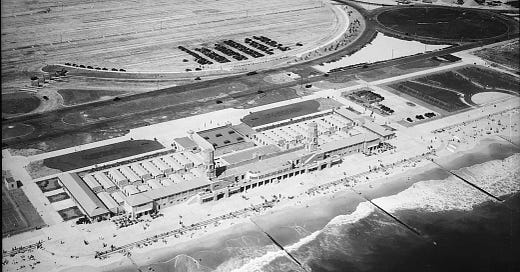The Beach That Makes You Gay
Aqueous disease and desire by way of Thomas Mann and Garth Greenwell
Over drinks the other week, I confessed to a new friend that I was not fond of the beach. We were ranking bodies of water. She eyed me and responded, “And you call yourself queer?” I was a little thrown off by the indictment, by my own faux pas I had committed unknowingly. When I asked her what she meant, she spoke of the beach as a space of freedom. Freedom from clothing, mostly.
A few days later at a bar in Clinton Hill, I ran into a professor from undergrad — a sculptor who had exhibited work at a gallery space in our town my senior year. In a narrow suite in the arcade off of Main St., he leaned slim, vertical works against the wall: frankenstein-ed creations of bamboo, PVC pipe, a Watermelon Smash Buzzball. Erect, to be sure, but somehow never phallic. A gallery description read: “Black’s Beach is a treeless, sandy expanse, located approximately 15 miles north of San Diego… The northernmost end of Black’s is for queers; community forms through naked sunbathing, and beach-goers place marker objects near scrub bushes and small thickets of bamboo to meet up for sex.”
At work the next day, I asked my co-worker their thoughts on the matter. Is the beach a known gay entity? “It’s a daytime version of a gay bar & there’s water,” they replied. “Also,” they went on to add, “probably far enough from the city that straight guys could come and cheat on their wives with queers and not be found out.”
In the final scene of Thomas Mann’s “Death in Venice,” an elderly Gustav von Aschenbach sits on the beach and watches his resplendent Tadzio out at sea, as he has every day since their first together: “[Tadzio] paced there, divided by an expanse of water from the shore… a remote and isolated figure, with floating locks, out there is sea and wind, against the misty inane.” Unlike all other mornings, however, Tadzio acknowledged his onlooker and turns toward him in invitation:
It seemed to him the pale and lovely Summoner out there smiled at him and beckoned; as though, with the hand he lifted from his hip, he pointed outward as he hovered on before into an immensity of richest expectation. And, as so often before, he rose to follow (73).
As we learn in the subsequent and final paragraph, this is the precise moment of Aschenbach’s death, taken by the plague which had arrived in Venice several days earlier. Mann concludes with this striking, if false, image of Aschenbach rising to enter the waves and meet the object of his obsessive yearning — his final unraveling — in the watery “expanse” he has dared not explored previously. (He actually just dies in his beach chair.)
To Mann, obsession and sickness fester upon each other. As illness overtakes Venice, Aschenbach grows bolder in his affection towards Tadzio, following him into the city where he catches the plague:
The city’s evil secret mingled with the one in the depths of his heart… these things that were going on in the unclean alleys of Venice, under cover of an official hushing-up policy — they gave Aschenbach a dark satisfaction (53).
The dirtying of Aschenbach’s hetero-fortitude cannot occur without the similar sickening of society; with the slip of proper functioning, a dissent into chaos and plague, comes Aschenbach’s own.
And it is the ocean which ushers in this unraveling. The sea is a sensuous and grotesque space: it is what carries death into Venice and pushes it through the damp and liquid city (62). The plague victim literally becomes water, losing the power to “expel the water secreted by the blood-vessels,” and drowns in his own body (63). Mann describes the seaside always with a hint of both sex and violence: a “grey sea” with “hard wet sand”; water “slapped gurgling,” with a “faintly rotten scent”; the sun rises above the ocean with “great quivering thrusts like golden lances.” It is not until Aschenbach surrenders himself to the water (if only in his plague-adled mind), that he can give himself over fully to his queerness, and with it, his death. The sea marks the transition between respectable, concrete worlds into an aqueous formlessness that gives its victim everything he has desired.
Of course, this blurring between sickness and desire is greatly informed by its context: a recent 1911 outbreak of Cholera in Italy from colonial exploits, a persistent stigma between gayness and disease across Europe (and beyond), and Mann’s own lifetime of sexual repression and internalized phobias. In literature, sickness is often a metaphor for moral disease, or so we learned in How to Read Literature Like a Professor in 9th grade. What does that mean for Aschenbach’s gay soul?
Across his novels, Garth Greenwell writes of queer eroticism alongside disease: the constant threat of sexually transmitted infections amidst a post-wall Bulgaria where desire is hidden in public bathrooms and private bedrooms. His narrators are, at times, consumed by the potential of both emotional and viral connection through “dirty” and/or unsafe sex: a doomed companionship.
Garth Greenwell’s debut novel, What Belongs to You, is in many ways a nod to “Death in Venice.” An unnamed narrator journeys to the Bulgarian seaside to visit his sick lover: a boyish, beautiful man named Mitko he met while cruising in Sofia. Away from the brutalist capital, the narrator leaves Mitko in bed in search of the sea (“it was the sea I longed for now”), but is always cut off by construction sites, discotheques, the highway. He doesn’t make it to the ocean until after he has fought and broken up with Mitko, who was not really his boyfriend but a sex worker. “I wanted to see the water, but not just see it; I wanted to be close to it, to imagine if not to feel the unearthly cold of it” (57).
Later, while returning home from the sea, the narrator becomes entranced by a young, Tadzio-like boy in his train car: “He was a beautiful child, slim and long-limbed, his skin bronzed from his vacation at the sea” (161). The boy is spoiled, charming, intoxicating: the narrator realizes he reminds him of Mitko, “before he had become what he was now”(166). He does not see Mitko again until 2 years later when he shows up at the narrator’s door to inform him he has syphilis, probably had it while they were together, too.
In my eyes, Greenwell’s narrator is an elaborated Aschenbach, transported from Venice to Bulgaria in the early 21th century. He is transfixed, obsessive, about the threat of illness, yet cannot look away. Finds it erotic, even. He yearns for the sea, despite, or because of, its brutalities. Against his own moral fortitude, he falls enamored with a beautiful, brattish young man/boy and suffers an illness because of it. In his second book, Cleanness, Greenwell’s narrator even visits Venice with his boyfriend in a direct call to the canon: “I could almost convince myself of it, Aschenbach stepping from uncertain water to stone” (124), Here, Greenwell references the moment Aschenbach enters Venice, and thus the beginning of his end.
Yet, unlike Mann and Aschenbach, Greenwell and his literary manifestations start to untangle the sublimations of self-hatred and queerness from dirt and disease and obsession. His narrators are not made “clean” by something like the ocean, as the title of Greenwell’s second book may suggest, but learn to welcome “filth” and cautiously find a life of desire without shame. A final sentence in Cleanness speaks of a dog let into the house and the dirt she tracks inside: “It would leave a mark, I knew, I would have to scrub it out in the morning, but what did it matter, I thought as I closed my eyes, what does it matter, why not let it stay” (223).
As much as I love Greenwell’s writing, I wonder what is lost in redeeming the Aschenbach character in his novels, “cleansing” them of their shame through teaching them their desire does not need to be shamed at all. What works so perversely in “Death in Venice” is how Aschenbach never learns what Mann himself understands so clearly, despite himself being closeted and forced to sublimate his own desire into his writing. Not that we should bring back gay shame. But that, there is nothing Greenwell knows that his narrator does not come to learn and that makes it all a little more boring.
If not to Fire Island, the New York queers go out to Jacob Riis Beach on Rockaway, a former military base built up by Robert Moses in the 1930’s and dubbed “the people’s beach.” By the 40’s, Riis was a space for gathering, cruising, softball, and bottomless sunbathing (until 1983). Audre Lorde writes of it in Zami. Neponsit Hospital sat just behind the shoreline until its demolition in 2023. In 2018, Ms. Colombia, a Manhattan queen and Riis beachgoer, was found murdered in the water there. Over the last century, Jacob Riis Beach has been closed and re-opened: oil-spills, sewage problems, beached syringes.
I biked out to Jacob Riis on my twenty-third birthday. In the South, May means summer: the letting out of school, the beginning of the endless season of sweating. In the North, May remains stubbornly spring: gray and always a little too cold. The forecast promised rain but I went anyway. To get there, I followed the Gowanus Canal south, which is famously one of the most polluted bodies of water in the world. Apparently, there is syphilis in there. Or maybe gonorrhea.
When I got there, the beach was empty, save me and the wind, so I sat on a rock and took in the greenish waves beyond.




and I’ve always said the beach is for the girls and the gays